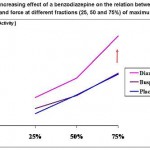Usefulness of the methods
The term muscle relaxant includes drugs of very different origins, mode of action and clinical value. Our methods which combine force measurement with the concomitant recording of surface EMG under well-defined experimental conditions display an impressive differentiation of drugs generally summarised under the term muscle relaxant.
Principle of the methods
 The volunteer follows with a hand grip (dynamometer) isometric-dynamic force paradigms in sequentially adjusted fractions (25, 50 and 75 %) of the individual maximum force (static load paradigm, EMG-Force-Slope) as well as a continuous dynamic Load with 30 % of the maximum individual force for 5 minutes (dynamic workload paradigm; for experimental set-up see fig. left). Our dynamometric unit records simultaneously amplitude and frequency of the flexor and extensor surface electromyogram (EMG) – as well as the muscular force in the mechanogram.
The volunteer follows with a hand grip (dynamometer) isometric-dynamic force paradigms in sequentially adjusted fractions (25, 50 and 75 %) of the individual maximum force (static load paradigm, EMG-Force-Slope) as well as a continuous dynamic Load with 30 % of the maximum individual force for 5 minutes (dynamic workload paradigm; for experimental set-up see fig. left). Our dynamometric unit records simultaneously amplitude and frequency of the flexor and extensor surface electromyogram (EMG) – as well as the muscular force in the mechanogram.
In addition, in the state of muscular fatigue, muscle contraction can be initiated by electrical stimulation of the muscle (force) and the EMG response can be recorded under this impact (to discriminate peripheral from central muscular fatigue).
Advantages of the methods
The simultaneous assessment of the muscle’s force and electrical activity differentiates drugs (i) acting by spinal inhibition, (ii) producing peripheral muscle relaxation with consecutively increased innervation (extensor and flexor amplitude and frequency) and (iii) causing peripheral muscle relaxation without increased innervation. The peripheral types of drug action can ideally be evidenced by direct electrical stimulation of the muscle in the state of muscular fatigue.
Reference data
 Data are available for various muscle relaxants and for benzodiazepine and non-benzodiazepine type of anxiolytics (for an example in different behaviour of the latter ones see the figure left).
Data are available for various muscle relaxants and for benzodiazepine and non-benzodiazepine type of anxiolytics (for an example in different behaviour of the latter ones see the figure left).
Options
- Evidence of a drug’s muscle relaxant activity/potency
- Characterisation of muscle relaxants with respect to mode of action, onset and duration of action and the dose-effect relationship
- Concomitant pharmacokinetics (pd/pk)